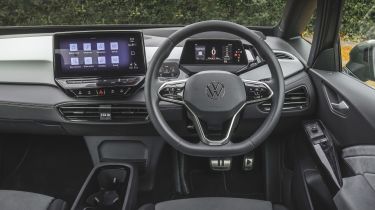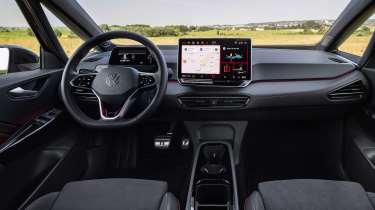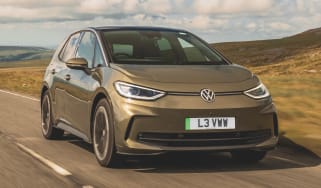Volkswagen ID.3 hatchback - Interior & comfort
The Volkswagen ID.3 is futuristic, but only facelift cars get the soft-touch materials commensurate with this car’s £35,000-plus price
The Volkswagen ID.3 features a futuristic-looking interior design based heavily around touchscreens and touch-sensitive buttons. All the familiar elements of a car interior are here but not quite as you might expect them.
VW ID.3 dashboard
There are few physical controls, which could be off-putting for fans of a more traditional interface, and the ID.3’s digital screens are especially prominent compared with VW interiors of the past. The touchscreen infotainment takes centre stage, like it does in the Tesla Model 3, and appears to float in front of the dashboard.
Meanwhile, the instrument display sits like a tablet behind the steering wheel. Like in the BMW i3, the gear selector sprouts from the instrument pod, which may take a bit of getting used to but is only needed to select drive, reverse and park.
A light bar beneath the windscreen changes colours to interact with the driver, glowing white when 'listening' to voice commands, giving directions in blue, warnings in red and showing an incoming call by turning green.
The futuristic approach is not surprising – this is the car that represents a new era for Volkswagen after all – but the drop in quality was more of a shock for loyal Volkswagen owners. Soft-touch materials were sparse, replaced with lots of grey and scratchy plastic that were a big backwards step for a brand that built its name on quality. Electric cars are expensive to produce and we can only imagine this has made margins tight – especially as the ID.3 isn’t much more expensive than a mid-spec Golf.
More reviews
In-depth reviews
For the 2023 mid-life facelift, Volkswagen added more soft finishes, with foam-backed touch points in response to customer feedback. The animal-free interior also uses an ‘Artvelours Eco’ microfibre material for the door trims and seats that uses more than 70% recycled material, while the GTX gets a combination of microfibre and vegan leather. This has made a huge difference to perceived quality – the ID.3 finally feels worthy of its rather lofty list price, meaning it can comfortably compete with rivals like the Renault Megane E-Tech and Kia Niro EV.
A 12.9-inch touchscreen is now standard, replacing the old 10-inch unit, and while Volkswagen’s fiddly touch-sensitive slider controls have unfortunately remained at the latest facelift, they are at least now backlit, so you can see them at night.
Thankfully, our early experience suggests some of the software bugs have been banished too, so it’s a much less laggy, more intuitive experience now. That said, with standard Apple CarPlay and Android Auto, most drivers probably won’t need to interact with the ID.3’s native software too much anyway.
Equipment
Since its launch, the ID.3 range has included a whole host of models, each with various equipment packs. As of 2024, the range is split between Pure, Pro and Pro S models to denote battery sizes, and each of those gets Essential and Match trim levels. Topping the range is the GTX Performance.
Standard equipment on every ID.3 includes LED headlights, all-round parking sensors, adaptive cruise control, sat nav and keyless start. There’s also a digital dash, lane keep assist and heated front seats on every car.
Volkswagen’s changes make it hard to keep up, but Pro models both get 18-inch wheels (steel with trims on the Essential, alloy on the Match), and Pro S both get the same design of 20-inch alloy wheels. Above Essential trim, Match models add niceties such as keyless entry, a rear-view camera, LED matrix headlights, and rear tinted glass. In GTX form you get a little more besides, with unique 20-inch alloys, 30-colour ambient lighting, Harman Kardon audio, an augmented reality head-up display, adaptive chassis control, and progressive steering.
Options
While there aren’t many individual extras for the ID.3, the facelifted version saw the introduction of option packs, which group together popular features. For instance, the Exterior Pack includes new two-part LED rear light clusters, which replace the more basic reflectors fitted as standard.
Buyers who want to preserve as much range as possible can add an energy-efficient heat pump for around £900 to either the Pro or Pro S, which should save precious miles in particularly extreme conditions – hot or cold. All owners can pre-heat or pre-cool the cabin from the car’s smartphone app, however.
The 12.9-inch infotainment system looks futuristic and comes with Apple CarPlay and Android Auto as standard, the move away from physical buttons has made it a little fiddly to use.














